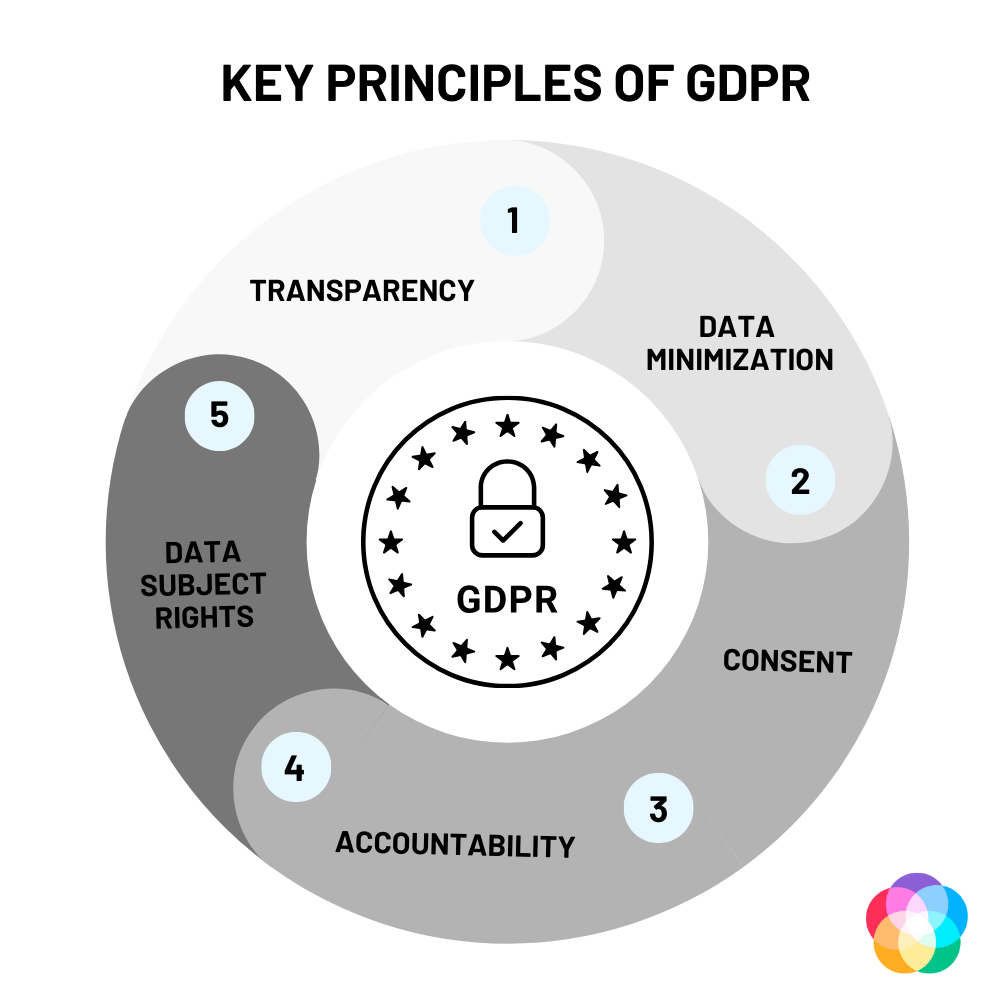The General Data Protection Regulation (GDPR) is a significant data protection law that came into effect in the European Union on May 25, 2018. If you’re handling personal data of individuals in the EU, GDPR is something you need to understand.
It replaces the older Data Protection Directive 95/46/EC and aims to harmonize data privacy laws across Europe. This regulation is all about protecting and empowering your data privacy while reshaping how organizations handle your personal information.
Understanding GDPR’s scope
GDPR applies to any company processing the personal data of people residing in the EU, regardless of where the company is based. So, even if you’re running a business outside the EU but dealing with EU citizens’ data, GDPR affects you. Personal data includes anything that can identify you, like your name, email address, location data, or online identifiers.
- Key principles of data processing: When it comes to data processing, GDPR emphasizes several principles. First, your data must be handled lawfully, fairly, and transparently. It should be collected for specific, legitimate purposes, and only the necessary data should be gathered. Ensure your data is accurate, compliant, and kept up to date. Store it only as long as needed, and process it securely to maintain its integrity and confidentiality.
- Your rights under GDPR: GDPR gives you several rights regarding your personal data. You have the right to access your data and understand how it’s being used. If any information is inaccurate, you can request corrections. You can also ask for your data to be deleted under certain conditions, which is known as the “right to be forgotten.” If you want to limit how your data is used, you can request processing restrictions. Additionally, GDPR allows you to obtain and reuse your data across different services, and you can object to data processing in specific situations.
- Accountability and governance: Organizations must show they’re complying with GDPR principles. This means they need to implement appropriate measures to protect your data. Some companies, especially those handling large-scale processing of sensitive data, must appoint data protection officers (DPOs) to oversee their data protection strategies.
- Data breach notifications: If there’s a data breach, organizations are to report it to the relevant authority within 72 hours, unless it’s unlikely to pose a risk to your rights and freedoms. This ensures you’re aware of any potential threats to your data.
- Penalties for non-compliance: Failing to comply with GDPR can lead to significant fines. Companies could face penalties of up to €20 million or 4% of their annual global turnover, whichever is higher. This highlights the importance of adhering to GDPR regulations.
GDPR enhances the protection of your personal data and gives you more control over your information. It provides a consistent legal framework across Europe, also making it easier for companies operating in multiple countries. By enforcing strict data protection measures, GDPR helps build trust between you and organizations, ensuring transparency in how they are using your data. Moreover, GDPR has influenced data protection laws globally, setting a standard for privacy legislation worldwide.
Everything we will discuss here is about safeguarding your personal data, giving you control, and ensuring organizations treat your information with the respect and security it deserves.
Key principles of GDPR
Understanding the key principles of GDPR is crucial for ensuring data protection and compliance. Let’s dive into the main aspects of transparency, data minimization, accountability, consent, and data subject rights.

- Transparency: Transparency ensures you are fully informed about how organizations collect, use, and share your personal data. As an organization, you must provide clear and accessible information about their data processing activities. This also includes details about the purpose of data collection, the entities involved, and how long the data will be retained. The goal is to ensure you understand what happens to your data and why.
- Data minimization: Data minimization means that organizations should only collect and process the data that is necessary for their specific purposes. This principle ensures that your personal data is not collected excessively or retained longer than needed. By limiting data collection to what is essential, organizations reduce the risk of data breaches and misuse.
- Accountability: Accountability requires organizations to take responsibility for complying with GDPR principles and to be able to demonstrate their compliance. This involves implementing appropriate technical and organizational measures to protect personal data. As an organization, you must also maintain records of their processing activities and, in some cases, appoint a data protection officer (DPO) to oversee compliance efforts. Accountability ensures that organizations are proactive in protecting your data and can prove their compliance if required.
- Consent: Consent under GDPR must be freely given, specific, informed, and unambiguous. This means that organizations must obtain your clear and affirmative agreement before processing your personal data. You should be provided with enough information to make an informed decision, and consent requests must be separate from other terms and conditions. Importantly, you have the right to withdraw your consent at any time, and the process for doing so should be as easy as giving consent.
- Data subject rights: The General Data Protection Regulation (GDPR) grants you several rights concerning your personal data, empowering you to have greater control over it. First, you have the right to access, which allows you to know whether your data is being processed and to access that data. If you find any inaccuracies, the right to rectification enables you to request corrections to any inaccurate or incomplete data. Additionally, the right to erasure, often referred to as the “right to be forgotten,” permits you to ask for your data to be deleted when it is no longer necessary for the purposes it was collected, or if you withdraw your consent.
Steps to achieve GDPR compliance
Achieving GDPR compliance involves a series of structured steps to ensure that your organization handles personal data responsibly and legally. Here’s a guide to help you navigate this process.
- Data auditing: First, conduct a data audit to understand what personal data you collect, how it’s processed, and where it’s stored. This will help identify any areas that need attention. Next, review and update your privacy policies to ensure they are clear and transparent, while providing individuals with information about their data rights and how you’re using their data.
- Create clear requests: Establish procedures for obtaining and managing consent. Make sure consent requests are clear and separate from other terms and conditions, and provide easy ways for individuals to withdraw consent. It’s also crucial to implement data protection measures, such as encryption and access controls, to safeguard personal data against unauthorized access or breaches.
- Indulge in staff training: Train your staff on GDPR requirements and data protection best practices. This ensures everyone understands their responsibilities and the importance of protecting personal data. Develop procedures for handling data subject requests, such as access, rectification, and erasure requests.
- Have data security procedures: Additionally, appoint a data protection officer (DPO) for data security if your organization processes large volumes of sensitive data or engages in systematic monitoring. Ensure you make these processes efficient so you can finish them within a short timeframe. And, you should establish a data breach response plan to quickly address any incidents and notify the relevant authorities within 72 hours if necessary.
Role of technology in GDPR compliance
Technology plays a crucial role in helping organizations achieve and maintain GDPR compliance. Digital tools like Lumiform can significantly streamline data management, policies, and automate compliance processes, making it easier to adhere to regulatory requirements.
Lumiform and similar tools offer structured frameworks for managing data efficiently. They provide digital checklists and forms that help you document data processing activities, ensuring consistency and accuracy. By using these tools, you can easily track consent, manage data access requests, while maintaining records of processing activities. This centralization of data management simplifies compliance and reduces the risk of errors.
Automating compliance audits offers several advantages. First, it increases efficiency by reducing the time and resources needed to conduct audits manually. Automated systems can continuously monitor compliance, providing real-time insights and alerts for any potential issues. This proactive approach allows you to address problems before they escalate.
Additionally, automation ensures consistency in audits, minimizing human error and providing a reliable audit trail. This is crucial for demonstrating compliance to regulatory authorities. By leveraging technology to automate these processes, you can focus on strategic improvements rather than administrative tasks, ultimately enhancing your organization’s overall data protection efforts.
Best practices for maintaining GDPR compliance
Here are five important best practices for maintaining GDPR compliance, explained in detail:
- Conduct regular data audits: Regular data audits are essential to understanding what personal data you hold, how it is processed, and where it is stored. By periodically reviewing your data inventory, you can identify any unnecessary or outdated information while ensuring that all data processing activities comply with GDPR principles. This practice helps maintain data accuracy and relevance, reducing the risk of holding excessive or incorrect data.
- Implement strong data protection measures: Protecting personal data is a core requirement of GDPR. Implement robust security measures such as encryption, access controls, and secure storage solutions. Regularly test and update these protocols to address new security threats and vulnerabilities. By protecting data from unauthorized access and breaches, you safeguard individuals’ privacy and build trust with your customers.
- Train employees: Employee training is crucial for effective GDPR compliance. Provide ongoing training programs to ensure that all staff members understand GDPR requirements and their roles in data protection. This includes recognizing data breaches, managing data subject requests, and handling personal data responsibly. Well-informed employees are your first line of defense against data mishandling and breaches.
- Manage consent effectively: Obtaining and managing consent is a fundamental aspect of GDPR. Ensure that consent requests are clear, specific, and separate from other terms and conditions. Provide individuals with comprehensive information about how you will use their data and offer simple methods for withdrawing consent. By managing consent effectively, you also respect individuals’ autonomy and maintain transparency in your data processing activities.
- Develop a data breach response plan: Having a well-defined data breach response plan is critical for minimizing the impact of any incidents. Establish clear procedures for detecting, reporting, and addressing data breaches. Ensure that your team can quickly notify relevant authorities and affected individuals within the 72-hour timeframe required by GDPR. A swift and organized response can also help you mitigate damage and demonstrates your commitment to data protection.
Start maintaining your GDPR compliance here
Maintaining GDPR compliance is an ongoing process that requires attention to several key areas. By conducting regular data audits, you ensure that the personal data you hold is accurate, relevant, and processed in compliance with GDPR principles.
Effectively managing consent is another vital aspect, allowing individuals to have control over their data and ensuring transparency in your data processing activities. Additionally, having a robust data breach response plan helps you quickly address any incidents, minimizing their impact and demonstrating your commitment to data protection.
To streamline these processes and enhance your GDPR compliance efforts, consider leveraging tools like Lumiform. Lumiform can help you efficiently manage data audits, consent, and compliance documentation, providing a structured framework that simplifies your compliance management.
